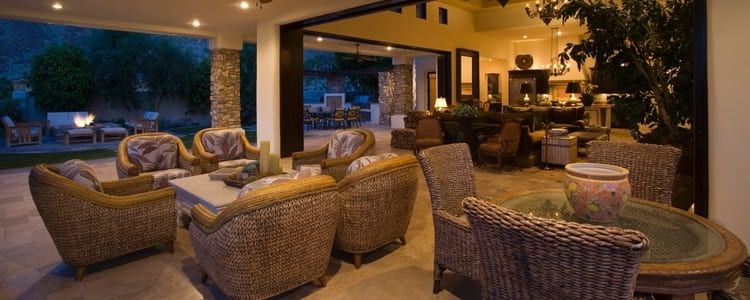
What is wicker furniture?
Two terms are critical to our understanding of what wicker furniture is, and they are wicker and rattan:
- Wicker is a technique for weaving products out of cane-like materials.
- Rattan is a material that comes from climbing plants and, given its flexible, sturdy consistency, is woven into furniture.
Wicker furniture is made of cane, durable rattan, raffia, and other natural fibers. The furniture is made using an ancient weaving technique, primarily for baskets.
Like basket weaving, the strips or reeds are woven together using strips that have been soaked wet earlier to make the weaving process easy. Later, the woven pieces are attached to a wooden structure for final shape and support.
Nowadays, synthetic wicker furniture is also available in the market and is used widely for many reasons, mainly because it is cheaper than natural wicker furniture.
How to tell the age of wicker furniture?
It is very important to know the age of your wicker furniture before buying it. Wicker furniture is preferred for its durability and beautiful woven pattern; hence, you must invest wisely.
- Research wicker furniture sellers; do not just head out and trust the seller. Find out where you can buy authentic wicker furniture.
- Carefully examine the wicker furniture that you are about to buy. Firstly, look at the bottom edges and corners as the old wicker furniture has some irregularities. The insides of the furniture and behind the doors are good places to look for irregularities.
- Styles and trends are constantly evolving and changing as time goes by. The same goes for wicker furniture regarding its weaving styles. For example, in the 15th century, the Chinese styled wicker furniture in loosely weaving peacock-shaped chairs, which enjoys its long-lasting popularity even today.
- Look out for the material from which the wicker furniture is made. As the old ones were handmade, consider closely examining the carvings, knobs, and spindles to see if they are handmade. Walnut wood and mahogany are used to make wicker furniture.
- If your research does not help you much, here are a few ways to find out for yourself.
- Closely examine the material of the furniture. If the reed is of poor quality, it will look dry and brittle.
- Test the comfort grade of the wicker by sitting on it, as this will tell you how sturdy the frame is.
- If you want to check whether the furniture is contemporary or an older piece, lift it and see if it weighs light or heavy, as older parts of wicker furniture tend to be heavy because of their solid frames.
- Labels on the furniture can help you figure out the age of the furniture, as certain companies were there only for a specific time.
- Never forget to check for insect damage. To do so, make a small hole in the wooden frame of the furniture and see if they do not eat the interior.
Natural and synthetic wicker furniture: which one to go for?

Natural wicker furniture
- Natural wicker becomes dry and brittle as time goes by. With time, it will crack and cause the weave to unravel.
- Insects and small pests are most likely to damage the natural wicker furniture.
- Natural wicker may fade outside in the sun, and during the rainwater may seep in and cause damage, as it is permeable; as a result, the fabric may give in to the seating area.
- Natural wicker is best used indoors.
Synthetic wicker furniture
- Synthetic wicker is infused with UV Inhibitors that save the furniture from fading in the sun.
- Synthetic wicker will not break, chip, or scratch and is also stain-resistant.
- Synthetic wicker is simple and easy to wash and clean.
- Synthetic wicker still costs less than natural wicker and is more sustainable.
- HDPE is 100% recyclable.
- Synthetic wicker can also be used indoors and outdoors.
For me, synthetic wicker works best, and I prefer it over natural wicker furniture.
Facts about wicker furniture
Here are some facts, good and not-so-good, on wicker furniture.
Wicker is not a type of material but a process’s name. As many may confuse it, Wicker is the material from which the furniture is made. Still, it is actually a process of weaving strips of either flexible rattan, willow, bamboo reeds, or synthetic polyethylene fiber, also known as resin wicker.
Natural wicker is woven onto a plant-based frame, while aluminum or tubular steel is used with resin wicker.
Natural wicker has been popular and in demand for centuries. Wicker furniture dates back over two millennia and was found in the excavation of the tomb of Egyptian pharaoh Tutankhamun. Wow! Can you believe that?
Wicker furniture comes in a wide variety of styles. You have plenty of options to choose from – patio, living room, bedroom, or children’s room furnishings; traditional, modern, country or industrial; loosely or densely woven – if that’s not already enough, there is wicker furniture out there to suit your taste and your lifestyle.
You will find tables, chairs, ottomans, sofas, dressers, beds, cradles, bookcases, storage units, home accessories, and more. So go out there and look for one, or maybe have it custom-made.
Comfortable and lightweight, the wicker is also strong. Due to its weaving process, wicker furniture has a comfortable amount of flexibility. It is easy to move and rearrange to your liking because it is light in weight. At the same time, the wicker is strong and very durable. For many people, natural wicker is scratchy to sit on, but don’t worry; cushions are a quick solution to this problem.
Wicker is beautiful and mesmerizing. The natural color of plant-based wicker is in attractive shades of beige. But it may also be painted in the hue of your choice.
Resin wicker comes in earthy colors like sage green, honey, and chocolate brown. How can something be so beautiful and a lot more simultaneously?
Wicker furniture is also eco-friendly. Rattan is a sustainable tropical vine-like type of palm that grows comparatively faster than trees in the same region. I
n addition, much of the synthetic material used in wicker production has also been recycled. Hence, a large portion of wicker furniture comes from renewable resources.
At times, natural wicker is used with other materials to make furniture. For example, if the chair seats or bookcase shelves are made of plywood, the glue used to attach them may off-gas hazardous chemicals such as formaldehyde. Let the buyer beware!
The sun damages untreated natural wicker, just as it is on human skin. So, revive and relax the wicker furniture on your deck with a soothing rub of lemon oil or boiled linseed oil, especially if you live in a hot, dry climate.
Natural wicker is more prone to mold. Instead, keep outdoor furniture fresh and extend its lifetime by bringing it inside during rainstorms and for the winter season. Trust me, that will save you a lot of bucks.
A garden hose is all you need to clean – a great way to get the dirt out of your wicker furniture’s little nooks and crannies is to use a garden hose.
Ensure the furniture has no wooden parts, and never saturate natural wicker with water. Set out in the sun to dry, or blow it with a hair dryer.
Sand down the rough spots on untreated plant-based wicker. Using fine-grained sandpaper, gently buff it using a light hand.
Save Big on Furniture Collection Up to 60%

